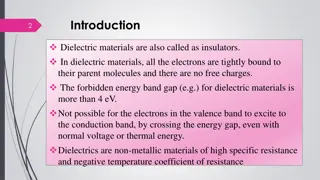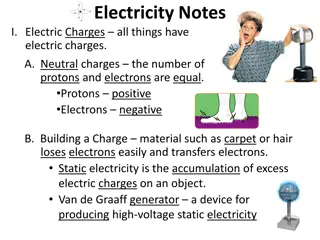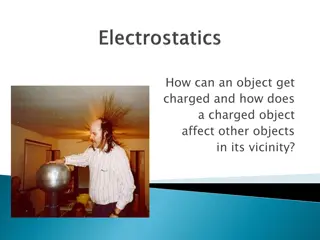Understanding Insulators and Energy Bands in Materials
Explore the concept of insulators and energy bands in materials, focusing on the forbidden gap, Fermi energy levels, and the classification of solids based on electrical conductivity. Learn about the role of insulators, the energy gap in insulators, and examples of insulating materials like rubber and plastic. Delve into the significance of Fermi level in describing electron energy levels at absolute zero temperature.
Download Presentation

Please find below an Image/Link to download the presentation.
The content on the website is provided AS IS for your information and personal use only. It may not be sold, licensed, or shared on other websites without obtaining consent from the author. Download presentation by click this link. If you encounter any issues during the download, it is possible that the publisher has removed the file from their server.
E N D
Presentation Transcript
Classification of solids Energy band of the material
Absolute zero,Temp increased FERMI ENERGY CHANGED
Classification of solids Classification of materials based on forbidden gap Forbidden gap plays a major role for determining the electrical conductivity of material. Based on the forbidden gap materials are classified in to three types, they are Insulators Conductors semiconductors Insulators
What is meant by insulator The materials which does not allow the flow of electric current through them are called as insulators. Insulators are also called as poor conductors of electricity.
Energy gap in insulators in insulators the valence band is fully occupied with electrons due to sharing of outer most orbit electrons with the neighboring atoms. Where as conduction band is empty, I.e, no electrons are present in conduction band. The forbidden gap between the valence band and conduction band is very large in insulators. The energy gap of insulator is approximately equal to 15 electron volts (eV).
Examples of insulators in insulators, this is practically impossible to move the valence band electrons in to conduction band. Rubber, wood, diamond, plastic are some examples of insulators. Insulators such as plastics are used for coating of electrical wires. These insulators prevent the flow of electricity to unwanted points and protect us from electric shocks.
FERMI LEVEL Fermi level" is the term used to describe the top of the collection of electron energy levels at absolute zero temperature. This concept comes from Fermi-Dirac statistics. Electrons are fermions and by the Pauli exclusion principle cannot exist in identical energy states.
Fermi level of solid state body The Fermi level of a solid-state body is the thermodynamic work required to add one electron to the body. It is a thermodynamic quantity usually denoted by or EF for brevity.
FERMI DIRAC FUNCTION The Fermi-Dirac distribution function, also called Fermi function, provides the probability of occupancy of energy levels by Fermions. Fermions are half-integer spin particles, which obey the Pauli exclusion principle.
FERMI DIRAC STATISTICS n quantum statistics, a branch of physics, Fermi Dirac statistics describe a distribution of particles over energy states in systems consisting of many identical particles that obey the Pauli exclusion principle. It is named after Enrico Fermi and Paul Dirac, each of
FERMI DIRAC STATISTICS In quantum statistics, a branch of physics, Fermi Dirac statistics describe a distribution of particles over energy states in systems consisting of many identical particles that obey the Pauli exclusion principle. It is named after Enrico Fermi and Paul Dirac, each of whom discovered the method independently.
The highest filled level, which separates the filled and empty levels at 0 K is known as the Fermi level and the energy corresponding to this level is called Fermi energy (EF). Fermi energy can also be defined as the highest energy possessed by an electron in the material at 0 K. At 0 K, the Fermi energy EFis represented as EF0. As the temperature of the metal is increased from 0 K to TK, then those electrons which are present up to a depth ofKBT from Fermi energy may take thermal energies equal to KBT and occupy higher energy levels, whereas the electrons present in the lower energy levels i.e., below KBT from Fermi level, will not take thermal energies because they will not find vacant electron states.
The probability that a particular quantum state at energy E is filled with an electron is given by Fermi-Dirac distribution function f(E), given by:
Analytical Treatment At 0 K: Substitute T = 0 K in the Fermi-Dirac distribution, we have
The curve has step-like character with f(E) = 1 for energies below EF0and f(E) = 0 for energies above EF0. This represents that all the energy states below EF0are filled with electrons and all those above it are empty.
As the temperature is raised from absolute zero to T1K, the distribution curve begins to departs from step-like function and tails off smoothly to zero. Again with a further increase in temperature to T2K and to T3K, the departure and tailing of the curves increases. This indicates that more and more electrons may occupy higher energy states with an increase of temperature and as a consequence the number of vacancies below the Fermi level increases in the same proportion. At non-zero temperatures, all these curves pass through a point whose f(E) =1/2, at E = EF. So EFlies half way between the filled and empty states.
Distribution functions are nothing but the probability density functions used to describe the probability with which a particular particle can occupy a particular energy level. When we speak of Fermi- Dirac distribution function
Here, by fermions, we mean the electrons of an atom which are the particles with spin, bound to Pauli exclusion principle.
Necessity of Fermi Dirac Distribution Function In fields like electronics, one particular factor which is of prime importance is the conductivity of materials. This characteristic of the material is brought about the number of electrons which are free within the material to conduct electricity.
As per energy band theory (refer to the article Energy Bands in Crystals for more information), these are the number of electrons which constitute the conduction band of the material considered. Thus inorder to have an idea over the conduction mechanism, it is necessary to know the concentration of the carriers in the conduction band.
Fermi Dirac Distribution Expression Mathematically the probability of finding an electron in the energy state E at the temperature T is expressed as
E=Ef is the Boltzmann constant T is the absolute temperature Ef is the Fermi level or the Fermi energy Now, let us try to understand the meaning of Fermi level. In order to accomplish this, put
This means the Fermi level is the level at which one can expect the electron to be present exactly 50% of the time.
Effect of temperature on Fermi- Dirac Distribution Function
At T = 0 K, the electrons will have low energy and thus occupy lower energy states. The highest energy state among these occupied states is referred to as Fermi-level. This inturn means that no energy states which lie above the Fermi- level are occupied by electrons. Thus we have a step function defining the Fermi- Dirac distribution function as shown by the black curve in Figure 2.
However as the temperature increases, the electrons gain more and more energy due to which they can even rise to the conduction band. Thus at higher temperatures, one cannot clearly distinguish between the occupied and the unoccupied states as indicated by the blue and the red curves shown in Figure 2.
The Fermi-Dirac Distribution The Fermi-Dirac distribution applies to fermions, particles with half- integer spin which must obey the Pauli exclusion principle. Each type of distribution function has a normalization term multiplying the exponential in the denominator which may be temperature dependent. For the Fermi-Dirac case, that term is usually written:
The significance of the Fermi energy is most clearly seen by setting T=0. At absolute zero, the probability is =1 for energies less than the Fermi energy and zero for energies greater than the Fermi energy. We picture all the levels up to the Fermi energy as filled, but no particle has a greater energy. This is entirely consistent with the Pauli exclusion principle where each quantum state can have one but only one particle.























